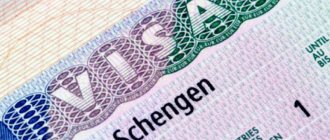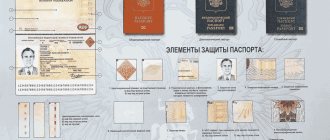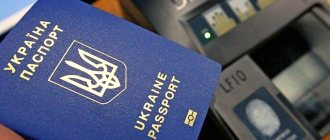Description
There is quite a lot of information on the visa sticker. Here we will tell you what each line is needed for:
- at the top, to the right of the photo there is the inscription “Issuing Post Number” - this is the identifier of the embassy;
- “Surname” – here the citizen’s last name is indicated;
- Accordingly, “Given Name” is his name;
- “Passport Number” – foreign passport number;
- in the “Entries” line – enter the number of permitted visits to the USA (M – multiple, S – one-time);
- in “Annotation”, consular department employees indicate, if necessary, additional information (for example, restrictions);
- “Control Number” – a combination of symbols that allows you to track your visa;
- the “Visatype/class” section contains a definition of the type of permit issued;
- “Sex” is the gender of the citizen;
- date of birth is given in the “Birth Date” column;
- nationality fits into “Nationality”;
- “Issue Date” indicates the day the visa was issued;
- the “Expiration Date” records the expiration date after which a person will not be allowed into the country;
- under the above-mentioned point there is also a visa number - it is red;
- Along the bottom edge there is a unique information code containing the name of the passport owner and a combination of characters.
Thus, the number you are looking for is in the lower right corner of the document. It's not too hard to find since it's the only one highlighted in color. You should know that the combination does not necessarily contain only numbers; letters are also quite common.
There is no need to worry about this - there is no mistake here.
Where is the visa type indicated?
There are different types of Schengen visa depending on the duration of the trip and its purpose. The most popular type is “C”, and it is most often issued for tourism and trips to visit relatives or friends, and business trips. The visa type can be seen under the date at the very top of the sticker in the passport.
What is a multivisa
You can find out what a Schengen multiple entry visa looks like by comparing the stamp in your passport with the mark indicating the possibility of single entry. They differ little - for a multiple entry visa the number is 0, for a single entry visa the number is 1, and for a double entry visa it is 2.
The “Mult” permit indicates where the visa was issued, what type it is, the duration of the visa corridor, the number of days for possible stay (for example, 90 days). At the bottom of the multiple entry visa there is also an encoding for quick identification by the scanner. How to get a multiple visa? You should act accordingly:
● you need to have travel to Europe, or better yet an annual Schengen visa;
● collect the required package of documents and pay the visa fee;
- submit the package to the visa center or consulate and wait to receive a stamp in your passport.
Obtaining a multiple visa is not easy, since you need compelling reasons for multiple entries into the EU and stable high income if you plan to stay there for a long time. If a person has never been to Europe before and immediately applies for a multiple-entry visa, then most likely he will receive a single-entry visa. The first time a multiple visa will definitely not be given for a period of 5 years. First, for six months to a year, then you can apply for a permit with a longer period of stay.
What information is included on the visa?
Having received permission to enter the European Union, the first thing you should pay attention to is the upper left corner of the sticker, where the Schengen visa number indicates the country of issue of the document. You will see a three-letter combination that border control officers use to determine the country of “first entry.” A complete breakdown of the values indicated in the text of the visa document is as follows.
- Valid for – territory of action. If we are talking about a Schengen visa obtained at the Spanish embassy, then the first line will indicate Estados Schengen. If the permit was issued in any other country, the inscription will be in the state language. On national visas, unlike Schengen ones, it will not be indicated “Schengen Union”, but a three-letter designation of the country to which the document is valid.
- From (beginning)… Until (end) – the validity period of the document.
- Type of visa – type or category. If the entry permit is single, then one Latin letter is placed, indicating the type of visa document. For multivisas, MULT is indicated.
- Number of entries – number of entries.
- Duration of stay – the allowed number of days of stay in the Schengen area.
- Issued in – city of issue.
- ON – date of issue.
- Number of passport – international passport number.
- Surname, name – surname and first name.
- Remarks – additional information for border control officers.
Reminder for travelers
A permit certificate is not considered a 100% guarantee of admission to European countries participating in the Schengen Agreement. Everything will depend on the authorized person in uniform at the border.
In addition to an identity card with a visa, the departing subject has the right to provide additional information to the migration officer. To confirm the purpose of the visit, they usually provide a hotel reservation and information from a travel agency, a letter from an employer or organization, and availability of valid health insurance. To prove to the migration officer that the owner of the passport and exit permit is financially secure, as a rule, they provide a certificate of the employee’s salary, as well as proof of the person’s solvency (bank card statement or cash). The migration officer can be provided with round-trip air tickets, as this also influences the final verdict.
After receiving a permit from the Consulate or Embassy of a Schengen country, you need to visually examine the visa. It is necessary to make sure that all inscriptions are made automatically, without any entries, marks, or corrections. The visa sticker bears the stamp of the Consulate, certified by an employee of the Embassy.
https://youtube.com/watch?v=52DDttpomAU%3Ffeature%3Doembed
uedem.net
Deciphering the Schengen visa
A plastic base must be applied over the personal data of the permit holder. How to find out what is hidden behind the permit details and determine the Schengen visa number? Let's break the permit certificate into paragraphs and read the information in detail.
The visa sticker is fixed in the foreign passport by the member states of the Schengen Agreement. It consists of several columns, which include a place for a photograph and an area for reading information about the owner in automatic mode.
"Valid for"
The paragraph indicates the territory of the state in which the owner of the document can move freely. The information may be indicated in the language of the issuing power, or in the form of an abbreviation, for example, ESP - Spain, ITA - Italy, FRA - France, FIN - Finland. The letter equivalent is indicated to clarify the information which consulate of the country issued this permit. If the scope extends to only one state, then its code is entered.
"From and Until"
Indicates the period for establishing a temporary corridor when a migrant can stay in the country. In other words, the date of opening of the country’s territory and the date of closure of the state’s border are indicated.
"Type of visa"
This paragraph indicates the type of permit to enter a Schengen country, marked A, B, C or D. It all depends on the purpose of the visa holder’s stay in the country. Category D is issued in rare cases, as it is not considered a Schengen visa, and therefore is not subject to the basic provisions of Schengen.
Decoding the Schengen visa in the passport
First, let's start with the appearance, this is what the entry permit to Europe looks like:
Explanations for the photo:
- The main information fields are highlighted in blue;
- The fields are numbered in red;
- Personal data (last name) is covered in green.
This picture shows a visa issued at the Hungarian Consulate in Kyiv, even before the introduction of a visa-free regime between the EU and Ukraine. For residents of Russia, everything remains the same, so this information remains relevant at the moment.
The only visual difference between it and the visas of other countries that are members of the “zone” is the use of the national language in the information fields along with English and French.
For example, in Finland Finnish will be used, in Austria German, in Italy Italian, and so on by analogy.
best posts By the way, do you know which countries are easier to get a visa for? Answer: Slovenia, Poland, Lithuania, Slovakia. But, you can read our post on this topic in more detail.
1. Valid for: SCHENGENI ALLAMOK (written in the language of the country that issued the visa, in this case in Hungarian “Schengen zone”). This means that the visa is valid for the Schengen area, which means you have the right to travel to all 26 countries that have signed this agreement. In addition, under certain conditions, you have the right to enter Croatia, Bulgaria, Romania and Cyprus.
2. Code of the country that issued the visa. HUN stands for Hungary.
Full list of codes for all European countries:
A (Austria), B (Belgium), CH (Switzerland), CZE (Czech Republic), D (Germany), DK (Denmark), E (Spain), EST (Estonia), F (France), FIN (Finland), GR (Greece), H (Hungary), I (Italy), IS (Iceland), L (Luxembourg), LT (Lithuania), LVA (Latvia), M (Malta), N (Norway), NL (Netherlands), P (Portugal), PL (Poland), S (Sweden), SK (Slovakia), SVN (Slovenia).
3.From . This field is read as the start date of the visa, that is, from what day entry is allowed. Entry on this date is not required; it can be done after, but not later than the date in the next field.
4. Until. The last day of validity of the visa, that is, the closure of the temporary corridor; after 23:59 hours of this date, the visa ceases to be valid.
Remember
The dates entered in fields #3 and #4 do not mean that you can stay in the Schengen area for that particular time.
The period of stay of one visit is indicated in column number 7 “Duration of stay”. We will consider this visiting rule further below. 5. Type of visa. Visa type, this field contains a letter that has the following meaning. There are 4 types in total:
- A (airport transit visa);
- B (transit);
- C (“visitor” visa);
- D (long term).
Most often, people apply for and receive a type C visa, which includes tourist, cultural, and sports trips.
6. Number of entries. Number of entries. Once upon a time I did not read this field, and only figured it out after the validity period had expired.
This visa gives you a corridor of three months, with the possibility of making two trips, but I only made one entry into Europe.
There may be designations in the passport:
- MULT - possibility of multiple visits;
- 01 - single entry;
- 02 - double entry.
7. Duration of stay. The number of days of stay during one period of entry, specified in the From and Until . It is always indicated in two digits, for example, in this case 15, but if the allowed number of days is less than 10, then zero comes first.
If the visa is issued as a MULT or double entry visa with a corridor for a year, and the number of days of stay is indicated as 30, 45, 60, 90 or another number of days, this means that each time you re-enter the Schengen area, the number of days is added up . If the number of days is over 90, then nothing is indicated in this field.
For example, you were issued a multiple visa valid from 01/01/2016 to 12/31/16 with a number of days of stay of 45.
From: 01/01/2016 Until: 12/31/16 Number of entries: MULT Duration of stay: 45
This means that within 365 days you can enter the Schengen countries more than twice, but the total number of days of stay should not exceed 45. For example, a trip in March for 10 days, a trip in August for 20 days, and a trip to October for 15 days, a total of 45 days of stay. Further, the visa is considered valid, but closed, since you have completed the required number of days.
8. Issued in. The city or authority where the visa was issued.
9. On. The date of issue of the document, not to be confused with the beginning of the action. In our example, the validity of the visa began 4 days after the date of issue.
10. Number of passport. Passport ID.
11. Surname, Name. Last name and first name.
12. Remarks. This field indicates the purpose of the visit. Each country writes differently. In this case, the purpose of the Hungarian visa is “Culture”. The Polish consulate usually writes CELWYDANIA: 01, which means a trip for the purpose of tourism.
13. Encoding. It is read at the border through a special machine by the border service.
The following data is encoded in it:
- The first letter V stands for visa;
- The second letter A, B, C, D - indicates the type of visa;
- This is followed by the designation of the country that issued the visa - HUN, POL, D, ESP and so on;
- This is followed by the surname and first name;
- The numbers in the second line are the visa sticker number;
- Next, the citizenship of the applicant;
- Date of Birth;
- Check digit;
- Floor;
- Number of entries;
- Effective start date.
All the data that is specified in the visa above is entered here, only the designations are in abbreviated form, intended for decoding by a computer.
A good example
Many people need to know where the visa identification number of the Schengen member countries is indicated due to various circumstances?
The visa number of the member states that have signed the Schengen agreement is located in the upper right corner. It consists of alphabetic and numeric values, sometimes just 9 numbers.
This permit was issued by the Finnish Embassy, since the letters FIN are recorded on the document. You will immediately notice the permit type mark – C, which means that the visa is for a tourist purpose. The period of stay on the territory of a state that has signed the Schengen agreement is valid from 08/05/08 to 08/04/09. it turns out that during the year the certificate holder can visit the selected state. In the section on the number of entries into the territory of Finland there is “MULT”, which means that the border of the Schengen zone can be crossed an unlimited number of times. The number of days is 30 - means the maximum time of stay on the territory of the selected Schengen state. Visa number is FIN7370735.
Sometimes there are situations when the time corridor is set too long, and the number of days of stay in the country is made on request. This is explained in order to protect the owner of the permit from unforeseen circumstances. Such situations may include plane delays, late departures and other force majeure events. This indicator helps you navigate the time of departure and arrival.
Difficult situations
It may be difficult to identify some information. Next, we will tell you in more detail about the details of visa documents.
Latest biometric visa number
Since 2015, the Schengen states have introduced a mandatory biometric procedure for issuing visas. Travelers coming from Russia, Kazakhstan, Belarus and other countries take a biometric photo at a foreign mission and submit fingerprints.
This information is located in the database of issued permits, which eliminates errors when processing visa documents by namesakes and facilitates personal identification. The frequency of updating biometric information is every five years.
The visa form for biometrically verified travelers is no different from the appearance of a regular permit. The document number is indicated, as in the general situation, in the upper right corner.
The visitor does not need to confirm the validity of the biometrics, since these data are entered into the VIS database and are verified without fail each time an entry permit is issued to any of the Schengen states.
But when obtaining a residence permit with the intention of subsequent registration of foreign citizenship, it is impossible to avoid re-submitting biometric information, since the database for repatriates does not intersect with the VIS.
National identification number
In European countries, tax identifiers are used - identity cards with individual numbers assigned to each taxpayer. Information about the inclusion of the specified details is written in the response to one of the points in the visa application form, which requires entering a national identification number.
Considering that in Russia there is no such identification card, filling out this column is not necessary. Representative offices of some states require Russians to enter the number of the applicant’s national passport (together with the series, without spaces) in this section of the application form.
How to find out the visa number if you have a passport number
The visa number can be found through the website of the visa center of the country you are visiting, indicating the passport number and other personal data of the owner.
Information about the issued entry permit is also included in air tickets. This procedure is provided for when purchasing tickets from Aeroflot and other companies.
But the easiest way is to check the visa number directly against the sticker made in the owner’s passport.
What does a pro-visa look like?
The pro-visa looks like an A4 form with a table with the tourists’ data entered in Latin letters. The pro-visa is free, and you can apply for it online 1-2 days before departure. To do this, you only need to fill out an electronic template, and you do not need to provide any documents (copies of passports, work certificates, etc.). The main requirement: the passport is valid for more than 6 months at the time of submission. If you purchase a tour through a tour operator, fill out the company’s internal questionnaire. Travel agency employees, based on the data provided, will fill out a visa application form themselves.
But it is worth keeping in mind that if any questions arise from the consulate, a call to the embassy or a request for additional documents is possible. It is undesirable to have Northern Cyprus stamps in your passport: in the vast majority of cases, this threatens to be denied entry into the territory of the Greek part of Cyprus in the future. Officially, the country's authorities have pledged not to interfere with entry and exit through the ports and airports of the northern part of the island, but in reality, unfortunately, the opposite is still happening.
There are simplified visa regimes between countries. One example is the Cyprus pro-visa.
It is noteworthy that for the establishment of a simplified visa regime with Russia, Cyprus annually pays a fine to the European Union. However, it can be assumed that the state’s income from the influx of Russian tourists is significantly higher, since the regime has existed for five years.
www.kakprosto.ru
How to apply for a visa
Despite differences in document requirements, the process of obtaining a visa is unified. If you are traveling to Austria, Germany, Greece, Denmark, Iceland, Lithuania, the Netherlands, Portugal or the Czech Republic, you will need to register on the VFS Global website. For each country, the resource has a separate page: you select the country of arrival and the country of residence in a special form, and the service finds a section with the necessary information.
For other Schengen countries there are separate registration portals:
- Belgium →
- Spain →
- Italy →
- Norway →
- Finland →
- Switzerland →
- Estonia →
Download the form in English and consent to the processing of personal data, fill it out and print it out.
- Austria: questionnaire; You will find the consent form for data processing here.
- Belgium: the application form will be sent to you by email after registration; consent to data processing.
- Hungary: questionnaire, consent to data processing.
Germany: questionnaire and consent to data processing (point 4). Greece: questionnaire, consent to data processing. Denmark: questionnaire, consent to data processing. Iceland: questionnaire, consent to data processing. Spain: questionnaire, consent to data processing. Italy: questionnaire, consent to data processing. Latvia: questionnaire, consent to data processing. Lithuania: questionnaire, consent to data processing. Liechtenstein: questionnaire, consent to data processing. Luxembourg: questionnaire. Malta: questionnaire, consent to data processing. Norway: to fill out the application you must register on the visa center website; consent to data processing. Poland: questionnaire, consent to data processing. Slovakia: questionnaire, consent to data processing. Slovenia: questionnaire, consent to data processing. Finland: questionnaire (registration required), consent to data processing. France: questionnaire, consent to data processing. Czech Republic: questionnaire, consent to data processing. Switzerland: questionnaire, consent to data processing. Sweden: questionnaire, consent to data processing. Estonia: questionnaire, consent to data processing.
What is a Schengen visa
A Schengen visa can be issued at the embassy of any European country. It gives you the opportunity to travel throughout Europe without issuing additional visas. The most popular type of Schengen is designated by the Latin letter “C” and is issued for a period of up to 90 days with different entry corridors (six months, a year, etc.). Multiple visas can be issued for up to 5 years. The “D” visa is also issued for longer periods – up to 180 days with the possibility of extension without leaving Russia. What is needed to obtain a Schengen visa?
- Collect a package of documents, which includes: application form, passport, certificate of employment, insurance, tour or hotel reservation, tickets.
- Pay the fee (30 euros at the visa center, 35 euros when submitting to the consulate).
- Submit the package of collected documentation and wait for a response (the average waiting period is 5-10 days).
According to the new rules of the EU Visa Code, even if you are denied entry into the country, you are required to provide a written explanation of why this happened. Previously, the consulate may not have commented on its decisions. If everything went well, then when you open your passport, you can find the coveted green sticker with your photo. For such stamps there are 8 sheets or 16 passport pages (o at the top). If the visa pages run out, the passport holder must issue a new document.
Decoding any Schengen visa is not particularly difficult. It must contain the permit number, country code, validity period, last day of stay in the Schengen zone, number of entries (1, 2 or Mult). The type must also be indicated (A – transit, C – for short-term stay (up to 90 days), D – for long-term stay).
How to read the bottom lines
At the very bottom of the visa stamp there is a field for automated reading. It contains 2 lines with identical information to the above items. The first contains the type of document, visa category, country code, last name, first name. Spaces are filled with "<".
Bottom lines of the Schengen visa
The second line contains:
- number from the upper right corner with a check digit (calculated through complex calculations according to the UN Civil Aviation algorithm, using data from the previous zone);
- nationality;
- date of birth with check digit;
- floor;
- date from the Until item with a check digit;
- intermediate sign “<” or area of action;
- number of entries (1, 2 or M);
- number of days of stay from the Duration of stay field;
- date in MM.DD format, indicating the beginning of the document’s validity.
The permit pasted into the passport is predominantly green and fits on 1 page. It must be certified by the signature of the consular officer and the seal.
It is necessary to read the Schengen visa and check the accuracy of the data provided upon receipt of the document. This will eliminate possible misunderstandings in the future.
How to read a Schengen visa instructions for use.
Here are the top questions that our clients often ask:
“How can this visa even be read?”
“How do I understand what dates the visa was issued for?”
“How do you know if this is a multiple visa?”
“How many days can I stay in Schengen with this visa?”
Often clients, upon receiving their passport with the long-awaited Schengen visa, are delighted. All expectations and doubts are behind us, now your passport has a brand new piece of paper that will serve as a pass to an unforgettable vacation or an important business trip.
It has repeatedly happened that already at home, after the first delight, the future tourist begins to look at his passport and think, and then call and ask questions.
Today we will clearly show how to solve these issues yourself. Let's look at the example of a finished visa:
- The visa number is indicated here. Each visa is assigned a unique number in the general Schengen database. The letter equivalent is encrypted by the country that issued this visa to you. ATTENTION! This does not mean that you can visit ONLY this country; this designation is used only to understand which country’s consulate issued you a visa.
- This column indicates the beginning of the temporary corridor. From this date, your visa becomes “open” for entry into the country.
- This column indicates the end of the temporary corridor. After this date your visa becomes expired. We strongly recommend that you leave the country no later than this date, otherwise you will not avoid trouble.
- The Latin designation encodes the type of visa. A – airport transit visa, B – transit visa with exit beyond the airport, C – tourist, D – this category is used when issuing a national visa (temporary residence permit). A category D visa is issued only for special cases and this category is not considered a regular Schengen visa, and accordingly is not subject to the general rules for Schengen visas.
- Number of entries. The number 1 or 2 may be indicated here, which will correspond to the allowed number of your entries (crossing the borders of the Schengen agreement) on this visa - one entry or two entries, respectively. If this column contains the inscription MULT, then you can make an unlimited number of entries, focusing only on the time corridor (indicated in paragraphs 2 and 3) and the number of days spent abroad (indicated in paragraph 6)
- The number of days you can spend in the Schengen area with this visa. As for single-entry and double-entry visas, everything is clear - the number of days booked in a hotel is equal to the number of days indicated on the visa. As for the multi visa, there is one trick. In this column, subject to a multiple visa, the rule is that the period of stay is 90 days. Let's figure it out further - if the corridor (points 2 and 3) of your multiple visa is six months or less, then o will mean that you can really stay in the Schengen zone for 90 days. If the corridor of your visa allows you to travel for a year, but the period of stay in the column is still 90 days, do not worry. This only means that you can use 90 days in each half of the year (the first half of the year is counted from the beginning of the corridor specified in paragraph 2). In total, you can stay for 180 days on an annual multivisa.
Rules for using a Schengen visa
There is a widespread belief that upon receipt of a Schengen visa, you can travel to any country that has signed the relevant agreement, and that there is absolutely no control over movements. However, it is not. In 2021, there are three rules for foreigners traveling on this type of visa:
Country rule
When visiting the Schengen zone once or twice, the country that issued the permit should be the one in which the largest number of travel days will be spent. If the length of stay is unknown, the second rule applies.
First State Rule
If the purpose of the visit is one country, then there is nothing to worry about. When planning a trip to several points in the Schengen zone, take into account that the country that issued the Schengen visa is located first on the list of visits.
How to correctly fill out passport tracking information
To prevent receiving a “no record...” response, you should familiarize yourself with some nuances:
- The passport number should be entered without any spaces, and the “No” sign should be replaced with N;
- the receipt number must be preceded by the abbreviation “MOAS” (Attention! The characters are printed in Latin);
- Enter the combination of these Latin letters completely, not even forgetting “/”.
Attention! You should remember and know that there is no information on the website about received or not received ready-made Schengen visas. . https://www.youtube.com/embed/_OVC93yNT70?feature=oembed
https://youtube.com/watch?v=_OVC93yNT70%3Ffeature%3Doembed
Checklist for checking the accuracy and correctness of personal data
Once you receive your visa, make sure all the information it contains is correct.
When reading the visa, look at:
- What is the passport number? This number must also be indicated on the visa. Make sure these numbers are the same.
- Make sure the entry and exit dates listed on your visa match your planned travel dates.
- Make sure your name is spelled correctly.
Do it yourself to avoid any problems or additional costs that may arise due to a small mistake or typo. If you believe your visa information is incorrect, please notify the embassy immediately so that the errors can be corrected.
We hope that now all the lines have become clear to our readers, and they have learned to read a Schengen visa and understand the intricacies of deciphering European abbreviations and abbreviations. Well, if something remains unclear, we will always be happy to answer your questions.
wayempire.com
Restrictions on length of stay for multiple visas
1. Any multiple visa has a limitation period on the total number of days of stay. For example, a visa can be issued for half a year, but the number of days is limited to 90. This means that during half a year you can stay in the Schenge zone for no more than 90 days.
2. For the Schengen area, the “90/180” rule applies. It means that within 180 days you can stay in the Schengen area for no more than 90 days.
Moreover, the days are counted from the last stay back, and not for a separate 180 days.
For example, you were in the Schengen zone for 30 days in January, 30 days in March, 30 days in May. This means that now you can enter in July: they will take into account 30 days in May, 30 days in March, and about 30 days in January (so that the total number of days back in Schengen does not exceed 90).
Or translating this example into the ordinal days of the year: you were in Schengen from the 1st to the 30th day of the year, from the 60th to the 90th day, and from the 120th to the 150th day. This means that now you will be able to move in no earlier than the 181st day of the year.
www.schengen.su
What information does the visa contain and what do the marks on it mean?
Check that the following items are present and filled out correctly:
- passport series and number;
- first and last name in Latin letters;
- validity period of the printed document;
- the exact number of days of stay in the country;
- clear consulate stamp.
Deadlines
If a visa opened in a foreign passport is valid for more than six months, then in this case the document will indicate the number of days during which you can live in the country every six months. For example, if a visa stamp is issued for a year, and in the column “number of days of stay” it is written “45”, then it should be taken into account that you cannot stay in the Schengen zone for longer than the specified period during the first and second half of the year.
What country was it issued by?
The visa issuing country is selected as follows. To obtain a visa sticker, apply to the consulate of the particular state for which the trip is being organized. If you plan to visit several countries, the visa stamp must be issued by the consulate of the state where the traveler plans to stay longer.
Where to look for your visa number
If you need to look at the Schengen visa number of the countries participating in the agreement, then finding it is easy: it is 9 characters in the upper right corner. Usually there are letters and numbers written there. But letters are not always found in the character set.











